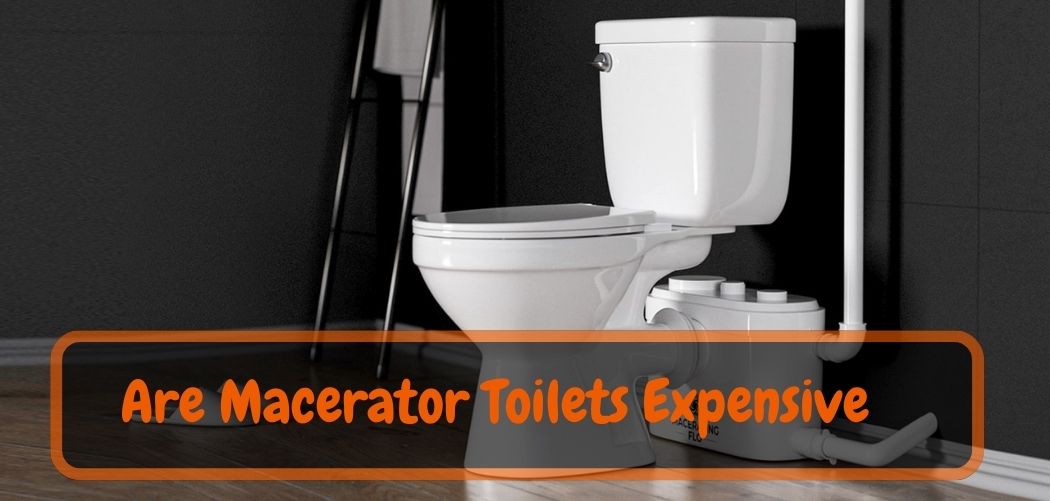When it comes to installing or replacing a toilet, one crucial aspect that often requires careful attention is the height of the toilet flange in relation to the floor.
The toilet flange, the circular pipe fitting that connects the toilet to the sewer drain, should ideally be at the right height to ensure a stable and leak-free installation. However, what happens if you find yourself facing a situation where the toilet flange is higher than the floor?
In this guide, we’ll explore the common issues and solutions associated with a toilet flange that’s elevated above the floor level, providing valuable insights into how to address this challenge for a successful toilet installation.
what if toilet flange is higher than floor?
If the toilet flange is higher than the floor, it can cause several problems when installing or replacing a toilet. Here are some potential issues and solutions:
01. Uneven Toilet Installation:
- If the flange is significantly higher than the floor, installing the toilet directly on top of it can leave the toilet rocking or unstable. This can lead to leaks and damage over time.
Solution: You may need to use extra-thick wax rings or toilet shims to level the toilet and create a stable seal. Alternatively, you can use a flange extender or spacer to raise the flange to the correct height.
02. Leaks:
- If the flange is higher than the floor, it may not form a proper seal with the wax ring or toilet gasket, which can result in leaks around the base of the toilet.
Solution: Use a wax ring with a built-in rubber gasket or an extended wax ring to help bridge the gap between the flange and the toilet horn. Make sure to tighten the toilet bolts evenly to ensure a proper seal.
03. Flange Replacement:
- If the existing flange is too high and damaged, it might need to be replaced. Removing an old flange can be a challenging task, especially if it’s secured to the subfloor or drainpipe.
Solution: You may need to remove the old flange and replace it with a new one at the correct height. This may involve cutting the drainpipe, installing a new flange, and securing it to the floor.
04. Subfloor Damage:
- A high toilet flange can indicate that the subfloor is damaged or uneven, which can cause further installation issues.
Solution: Before installing the toilet, check the condition of the subfloor. If it’s damaged or uneven, you may need to repair or level it before proceeding with the installation.
05. Professional Help:
- If you are not comfortable with plumbing and DIY projects, it’s advisable to seek the assistance of a professional plumber. They can assess the situation, make the necessary adjustments, and ensure that the toilet is properly installed without leaks or stability issues.
A toilet flange that is higher than the floor can present installation challenges and potential for leaks. It's essential to use the right materials, such as extended wax rings or flange extenders, and to ensure that the toilet is securely and evenly bolted down. If you're unsure about the installation process or encounter significant issues, it's best to consult a professional plumber for assistance.
Toilet Flange Floor Height Measurement Table
Here’s a table to help you understand the ideal toilet flange height in relation to the finished floor and the acceptable range:
| Flange Height Relative to Finished Floor | Description/Recommendation |
| Flush with Finished Floor | Ideal installation height for the flange, ensures stability and a proper seal with the wax ring. |
| Slightly Above Finished Floor (up to 1/4 inch or 6 mm) | Acceptable if needed for flooring variations, maintains a good seal with the wax ring. |
| Above Finished Floor (more than 1/4 inch or 6 mm) | Can lead to installation challenges, may require flange adjustment, extenders, or shims to maintain stability and seal. |
| Below Finished Floor | Not recommended; can result in an unstable toilet installation, potential leaks, and should be corrected. |
It's important to note that local building codes and plumbing regulations may specify the allowable flange height, so always check these guidelines for compliance in your area. Proper alignment of the toilet flange with the floor is crucial to ensure a secure, leak-free, and stable toilet installation.
How to Fix a Flange That’s Too High?
Fixing a toilet flange that’s too high involves adjusting its height to ensure a proper and stable installation of the toilet. Here’s a step-by-step guide on how to fix a high toilet flange:
Tools and Materials Needed:
- Adjustable wrench or pliers
- Screwdriver
- Flange extender kit (available at most hardware stores)
- Wax ring with a built-in rubber gasket
- Toilet bolts and nuts
- Level
- Hacksaw or reciprocating saw (if necessary)
- Subfloor repair materials (plywood or shims, if needed)
Steps:
- Turn Off the Water: Shut off the water supply to the toilet by turning the shut-off valve clockwise. Flush the toilet to empty the tank and bowl.
- Remove the Toilet: Use an adjustable wrench or pliers to loosen and remove the nuts from the toilet bolts located at the base of the toilet. Carefully lift the toilet off the flange and set it aside.
- Inspect the Flange: Examine the existing toilet flange to determine why it’s too high. It may be due to improper installation, damage, or previous flooring changes.
- Remove the Old Flange (if necessary): If the old flange needs to be replaced because it’s damaged or not adjustable, you’ll need to remove it. To do this, use a screwdriver to remove any screws or bolts securing it to the floor. If the flange is cemented or glued to the drainpipe, you may need to cut it using a hacksaw or reciprocating saw.
- Install the Flange Extender: If the existing flange is in good condition and just needs to be raised, you can use a flange extender kit. Follow the manufacturer’s instructions to attach the extender to the existing flange. This will raise the flange to the desired height.
- Check for Subfloor Level: Ensure that the subfloor beneath the flange is level. If it’s not level, you may need to add plywood or shims to level it. This is essential to prevent rocking or instability when the toilet is installed.
- Install a New Wax Ring: Place a wax ring with a built-in rubber gasket over the flange extender or the raised flange. The wax ring creates a watertight seal between the toilet and the flange.
- Reinstall the Toilet: Carefully lower the toilet bowl onto the wax ring, aligning the toilet bolts with the holes in the base of the toilet. Press down evenly to compress the wax ring and create a proper seal. Place a washer and nut on each toilet bolt and tighten them evenly using an alternating pattern to ensure even pressure. Be careful not to overtighten and crack the toilet.
- Check for Level: Use a level to ensure the toilet bowl is level both side to side and front to back. If it’s not level, you can use toilet shims to make adjustments.
- Reconnect Water Supply: Reconnect the water supply line to the fill valve on the bottom of the toilet tank. Open the shut-off valve to allow water to flow into the tank.
- Test for Leaks: Flush the toilet and check for any leaks around the base. If you see any leaks, tighten the toilet bolts slightly, but do not overtighten.
- Secure the Toilet: Once there are no leaks and the toilet is level, use a hacksaw or a reciprocating saw to trim the excess length of the toilet bolts, leaving enough for a cap or decorative cover. Install the caps or covers provided with the toilet bolt kit.
- Finish Installation: Reattach the toilet tank lid and any decorative caps or covers as needed.
By following these steps, you should be able to fix a toilet flange that's too high and ensure a proper and stable installation of your toilet. If you're not comfortable with the process, consider seeking the help of a professional plumber.
Should toilet flange be higher than the floor?
The toilet flange should typically be level with or slightly above the finished floor level. This ensures a proper and secure installation of the toilet. If the flange is too low, it may not create a watertight seal with the wax ring, leading to potential leaks.
On the other hand, if the flange is significantly higher than the floor, it can make it challenging to install the toilet securely, and it may result in rocking or instability. In such cases, it’s important to either raise the flange to the appropriate height using a flange extender or spacer or adjust the floor level to accommodate the flange properly.
Ensuring the correct height of the flange is crucial for a leak-free and stable toilet installation.
What if toilet flange is not level with floor?
If the toilet flange is not level with the floor, it can lead to various installation problems and potential leaks. A flange that is lower than the floor can result in an unstable toilet installation, causing the toilet to rock and potentially break the wax seal, which can lead to water leaks and damage over time.
Conversely, if the flange is higher than the floor, it can make it challenging to install the toilet securely and create a proper seal. In either case, it’s crucial to address the issue to ensure a stable, leak-free, and properly functioning toilet.
This might involve using flange extenders or spacers to adjust the flange’s height or making adjustments to the floor level to achieve a flush fit between the flange and the finished floor.
If you’re uncertain about how to handle an uneven toilet flange, it’s advisable to consult a professional plumber to ensure a correct and trouble-free installation.
How much higher than the floor can a toilet flange be?
A toilet flange should ideally be flush with the finished floor level or slightly above it, typically no more than 1/4 inch (6 mm) higher. This height allows for a proper installation that ensures a stable and secure toilet while maintaining a watertight seal with the wax ring.
However, the specific allowable height can vary depending on local building codes and plumbing regulations. It’s essential to check with your local authorities or consult a plumber to ensure compliance with these requirements when determining the appropriate height for a toilet flange.
Installing a flange lower than the floor can lead to instability and potential leaks, so achieving the correct height is crucial for the proper functioning and longevity of your toilet installation.
How do you know if the toilet flange is at a good height?
You can determine if the toilet flange is at a good height by considering a few key factors:
1. Flush with or Slightly Above the Floor:
The ideal height for a toilet flange is either flush with the finished floor surface or slightly above it, typically no more than 1/4 inch (6 mm) higher. When the flange is at this level, it allows for a stable and secure installation while ensuring a proper seal with the wax ring.
2. Stability:
When you place the toilet bowl over the flange, it should sit firmly and evenly on the floor without rocking or wobbling. If the toilet is unstable, it could be an indication that the flange is not at the correct height.
3. Wax Ring Seal:
After installing the toilet, the wax ring should create a tight seal between the toilet horn (the opening at the base of the toilet) and the flange. If there is a gap between the wax ring and the flange, it may suggest that the flange is too low.
4. Local Codes and Regulations:
Check your local building codes and plumbing regulations, as they may specify the acceptable height for toilet flanges in your area. Compliance with these standards ensures that your installation meets safety and sanitation requirements.
5. Consulting a Professional:
If you’re unsure whether the toilet flange is at the right height or if you encounter stability or sealing issues during installation, it’s advisable to consult a professional plumber. They can assess the situation, make necessary adjustments, and ensure that your toilet is correctly installed.
In summary, a good toilet flange height is one that allows for a stable, level installation, a proper wax ring seal, and compliance with local building codes. Ensuring the correct height is crucial to prevent potential leaks, instability, and other installation problems.
Frequently Asked Questions (FAQ) about Toilet Flange Height:
A1: If the toilet flange is higher than the floor, it can cause installation problems. You may need to use flange extenders or spacers to raise the flange to the correct height. Ensuring a proper seal with the wax ring and a stable toilet installation is essential.
A2: If the toilet bowl is unstable due to a high flange, it’s essential to address the issue. You can use toilet shims or adjust the flange height to ensure the toilet sits securely on the floor without wobbling.
A3: Yes, having a toilet flange up to 1/4 inch to 1/2 inch above the floor is generally acceptable. This allows for variations in flooring materials while maintaining a proper seal with the wax ring.
A4: If a cast iron toilet flange is too high, you may need to remove it and replace it with a new flange at the correct height. This can involve cutting the drainpipe and securing a new flange to the floor.
A5: If the toilet flange is lower than the floor, it can lead to instability and potential leaks. In this case, you should use flange extenders or shims to raise the flange to the appropriate height.
A6: To fix a large gap between the toilet and the floor, you can use toilet shims to level the toilet. Ensure that the flange is at the right height and that the wax ring provides a proper seal.
A7: If the toilet sits too high above the floor, it can be unstable. Check the flange height and consider using a thicker wax ring or adjusting the flange to ensure a secure installation.
A8: Yes, having the toilet flange flush with the floor is an ideal installation height. It ensures a stable and level toilet installation while maintaining a proper seal with the wax ring.
Closing Remark:
In conclusion, dealing with a toilet flange that’s higher than the floor can pose installation challenges, potentially leading to stability issues and leaks if not properly addressed.
Whether you choose to adjust the flange height using extenders, shims, or other methods, it’s essential to ensure that your toilet sits securely on the floor and maintains a watertight seal with the wax ring. This ensures the functionality and longevity of your toilet installation.
If you’re uncertain about tackling the issue on your own, don’t hesitate to seek the expertise of a professional plumber, who can help you achieve a safe and effective solution for your bathroom plumbing needs.









